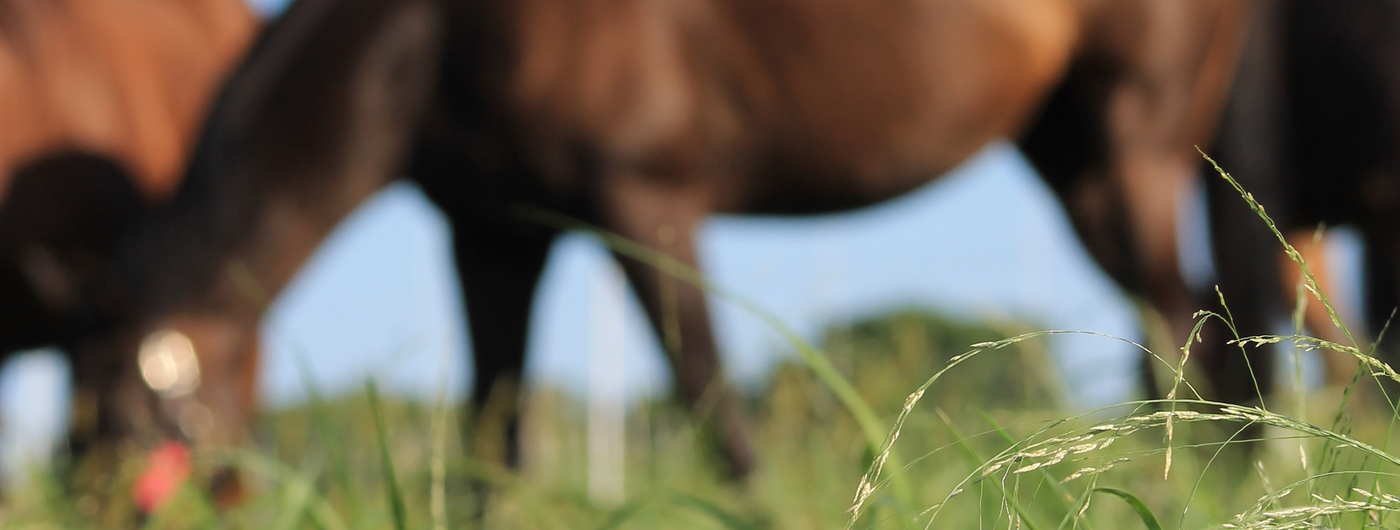Quick facts
- Warm-season grasses can supply forage during summer months and following winter kill of cool-season forages.
- Teff is a warm-season annual that shows potential as a horse pasture forage.
- Make sure to test teff for nitrates and calcium to phosphorus ratio before grazing.
Grazing during the summer slump
Pastures in the Upper Midwest mainly consist of cool-season grasses. However, many cool-season grasses go through a summer slump, resulting in reduced pasture productivity and forage quality during July and August.
Annual warm-season grasses have the potential to provide forage during the summer slump and can be used as emergency forage should cool-season grasses suffer winter injury. However, annual warm-season grasses are known to have high fiber content and lower crude protein (CP) and nonstructural carbohydrates (NSC) when compared to cool-season grasses. Most warm-season grasses are prone to building up nitrates, which can be toxic to most grazing livestock at high concentrations.
Horse preferences
Researchers grazed four adult horses on 'Summer Lovegrass' teff, 'PCS 3010' sundangrass, 'PCS 202' sorghum sudan BMR, Japanese millet, 'Red' Siberian millet, and 'Jumbo' annual ryegrass. All were planted in May of 2014 and 2015. Annual ryegrass served as a cool-season grass control.
Horses grazed the forages in rotation between June and September. Horse preference was determined by visually assessing the percentage of available forage removed on a scale of 0 (no grazing activity) to 100 (100 percent of the existing vegetation grazed down to 4 inches).
- Most preferred: Annual ryegrass, teff and sudangrass
- Least preferred: Sorghum-sudangrass, and Japanese and Siberian millet
Yield
- Sudangrass was consistently among the highest yielding grasses (more than 6 tons per acre).
- Siberian and Japanese millet and annual ryegrass were among the lowest yielding forages (less than 2.8 tons per acre).
Neither Siberian nor Japanese millet survived for the entire growing season, which may have resulted in their lower overall yields. All other annual grasses resulted in three or more grazing rotations during the summer and fall months.
These results indicate that annual warm-season grasses, with the exception of Siberian and Japanese millet, have the potential for high yields when grazed by horses. However, warm-season forages should not be grazed lower than 4 to 6 inches for optimal regrowth in a grazing system.
Nutritional values
Annual ryegrass consistently had higher crude protein and nonstructural carbohydrate levels, as well as lower neutral detergent fiber (NDF) content when compared to warm-season grasses. While warm-season grasses had a lower nutritive value, these forages met or exceeded the nutrient needs for adult horses at maintenance.
The lower NSC values in the warm-season grasses suggest they have the potential for owners managing horses diagnosed with metabolic conditions (such as equine metabolic syndrome).
It's important to note that an inverted calcium to phosphorus ratio (Ca to P) was observed in most forage species (the ideal Ca to P ratio is 1:1 to 3:1). If Ca to P is less than 1 to 1, horses will need a calcium supplement.
Nitrates
Some forages can build up high contents of nitrates (NO3-N) as a result of over fertilization or environmental stress. Nitrate toxicity is considered rare in horses. Previous research shows that horses can consume forage with nitrates as high as 4,600 ppm, before nitrate poisoning will be observed.
While all forages, except annual ryegrass, were at acceptable levels in 2014, they all exceeded 6,430 ppm NO3-N in 2015. Excessive drought and heat were not factors, so mineralization of soil nitrogen from past manure applications to the site may have contributed to the high nitrate values.
Nitrate toxicity was not observed, likely because the horses grazed these forages for short periods of time and in rotation with other forages. Nitrate concentrations should be determined prior to grazing warm-season grasses.
Warm-season forage recommendations
Based on maximizing yield, forage nutritive values and preferences, teff and sudangrass show potential as annual warm-season horse pasture forages.
Sudangrass can lead to prussic acid poisoning, cystitis syndrome and abortions in horses. While these conditions are more commonly observed under stressful environmental conditions including high temperatures, drought, and frost, they increase management concerns for horse owners.
Teff may be used in Midwest horse pastures as an emergency forage or to maximize grazing during the summer slump.
The low nonstructural carbohydrate content of warm-season annuals shows potential for these forages to be grazed by horses diagnosed with metabolic conditions. But due to the inverted calcium to phosphorus levels and higher nitrate concentrations, teff should be tested prior to grazing.
DeBoer, Michelle L., Craig C. Sheaffer, Amanda M. Grey, Devan N. Catalano, M. Samantha Wells, Marcia R. Hathaway, and Krishona L. Martinson (September 7, 2017). Yield, Nutritive value, and Preference of Annual Warm-Season Grasses Grazed by Horses, Agron. J. 109:2136-2148 (2017) doi:10.2134/agronj2017.02.0099.
Reviewed in 2024



